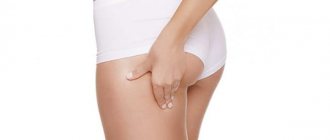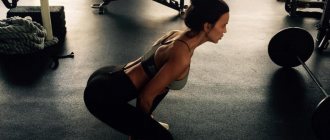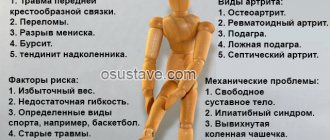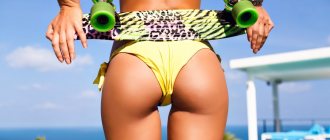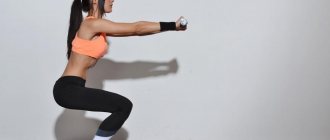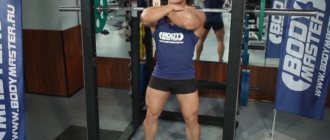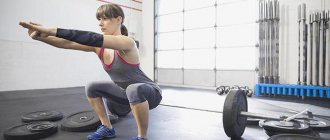Home › Exercises › Knee Squats
What should a girl do if she is a “complete zero” in the gym, but really wants to pump up her butt. There is only one answer - experiment. Today we will look in detail at one atypical exercise. Namely, knee squats. And we’ll find out how effective it is and whether it’s worth including it in your training program.
Of course, when a girl comes to the gym to pump up her buttocks, any trainer will immediately prescribe her a classic squat. In the end, it turns out that she wanted to enlarge her butt, but got bigger legs. This situation occurs very often.
And this doesn't mean that squats are a bad exercise. Everything is poison and everything is medicine. In other words, we need to feel exactly what we are doing in this or that exercise. The classic squat with an emphasis on the buttocks is a difficult exercise to perform.
Therefore, if you are new to exercise machines and exercise without a trainer, then it is better to pay attention to easier exercises. Kneeling squats are just one of them.
What muscles work
Knee squats can be classified as both basic and isolated exercises that are aimed at working the buttocks.
The complete atlas includes the following muscle groups:
- targeted – gluteus maximus;
- synergists - quadriceps, hamstrings, rectus abdominis, spinal extensor muscles.
Plie
An excellent look for working out at home and working out the same muscles of the buttocks and thighs.
The basis of the exercise is classic squats, in which you need to spread your legs and feet wide, and in order to get an elastic butt, it is advisable to squeeze your buttocks in the starting position.
Be sure to listen to your body, as this exercise requires a good stretch of the hip joints.
Benefits of Knee Squats
Knee squats have some advantages over classic squats:
- enlarge the buttocks without enlarging the legs;
- develop strength in the hips and buttocks;
- help overcome the “plateau” in basic squats;
- relieve stress from knee joints;
- strengthens the muscles of the lower back.
Note. This exercise is classified as “explosive”, which allows it to be used in a type of training such as pumping. The purpose of which is to fill the muscles with blood and, as a result, inflate them, which will make them visually larger.
Sumo squats scheme
1) Sit under the barbell and take it narrowly enough, as far as the stretch allows you, but so that it is comfortable for you to hold the barbell at the same time. 2) Place the barbell against the middle segment of the trapezius muscle, bend your back in the lumbar region, and head up. 3) The athlete must place his legs in scissors, then stand up with the barbell and take a step with his front leg to the side, and then place his second leg in line with it. 4) From the base position, the athlete sits down, moving the pelvis back, while the knees remain in the given direction throughout the entire range of movement. 5) When sitting down, the athlete tilts the body down, and when standing up, he must synchronously raise the pelvis and straighten the body, while the initial force is produced by the gluteal muscles.
Technique for performing knee squats
The exercise falls into the “easy as pie” category, but it also has some features. The technique is as follows:
- Set the bar to the desired height.
- Place the folded mat on the floor under the bar.
- Get down on your knees with your shins parallel to each other, shoulder-width apart.
- Place the bar behind your head at the bottom of your trapezius and remove it from the supports.
- Squeeze your shoulder blades and tighten your abs.
- As you inhale, begin to move your buttocks back until they touch the muscles of your lower leg (if stretching allows, you can go lower).
- Without pausing, exhale and return to a vertical position.
- Repeat the exercise a specified number of times.
Before performing, be sure to do a warm-up, since this exercise puts a high load on the spine, namely the lower section. If the lower back muscles are tight, it will be difficult to lift weights.
On a note. Any squats, including kneeling ones, are best done after hyperextension. Your back muscles will be well warmed up and it will be easier for you to work with heavy weights.
Execution options:
- free weight knee squats;
- knee squats in Smith.
Knee squats can be done either with free weight or in a Smith machine (most often). In the first case, all muscle groups are better loaded. In the second, the gluteal muscles are better emphasized, since the movement follows a strictly given trajectory (at least many people think so).
Interestingly, the Smith machine was originally conceived as a simulator for working out lagging muscles. Then it was taken over by newcomers with unproven equipment. And now most of the exercises, including basic ones, are performed exclusively in Smith.
If we consider the trajectory of movement, which will be physiologically correct, then the bar should not go straight, but along an inclined path. That is, Smith squats cannot be technically performed correctly, where the load is vertical.
What to pay attention to
To make the exercise as effective as possible, pay attention to the following points:
- When squatting, go as low as possible to give your gluteal muscles a good stretch.
- Lower slowly and rise quickly by pushing out.
- Hold in the top position for 1-2 counts, squeezing your buttocks.
- Lower as you inhale, rise as you exhale.
- Keep your back straight at all times.
- Do not place your knees directly under the bar, but bring them slightly forward.
- Don't look down, look forward so as not to break your technique.
- Choose the right weight so that the exercise is effective and does not cause injury.
Forward lean
If you lean forward when squatting—to the point where your chest touches your knees—you likely have weak hamstrings and weak glutes. By compensating for their weakness, you transfer the weight to stronger muscles - the quadriceps and back muscles. When training their legs, women often put more stress on the quadriceps - especially considering that in women involved in fitness, the quadriceps are already much more developed than the hamstrings. The quadriceps takes on most of the load to help the hamstrings get out of a tight position. Additionally, you should engage your core muscles to keep your back straight.
Bend forward when squatting
How to fix:Stretch: Stretch your hamstrings. The hamstrings must be flexible if you want to improve your squats. Bodyweight exercises: Box squats without a barbell. This will help you get a feel for what proper squat form looks and feels like. When you connect the barbell to work, do not form the weight of the weight at first. Quality first, quantity second! Weight exercises: Add front squats and overhead squats to your program. It will be more difficult for you to lean forward when you are forced to maintain proper ankle position.
How effective are knee squats for the buttocks?
According to some studies, knee squats have shown better results in the degree of gluteal muscle activity compared to other squats.
In theory, this may be true, but in practice, it’s better to try everything. Kneeling squats, although they are conditionally basic, are, in my opinion, worse than a classic squat with the pelvis pulled back and cannot provide the same effective muscle growth. To do this, just compare the angles in the classic version and in squats from the knees.
But such incomplete squats practically eliminate the work of the legs, which means that almost the entire load falls on the buttocks (albeit not so powerful). There is some advantage to this. And it’s difficult to make mistakes in this case.
Note. I would recommend this exercise more for inexperienced girls. And for those whose naturally quadriceps grow faster than their buttocks.
In general, basic exercises have always been and will be the best for building high-quality muscle mass (which will not go anywhere if you suddenly give up training for a month). Therefore, knee squats should be considered only as an addition to visually fill out the buttocks and give them shape.
General recommendations
Relief exercises should be multi-repetitive (up to 15-20 per set). Also, high-repetition exercises are used by athletes to get out of a training plateau, as well as to dry and burn fat. But you shouldn’t expect that only regular squats at an accelerated pace will help you shape your body, burn fat, and tighten muscles. A quick and stable result is influenced by several factors, including a balanced diet and proper rest, sleep lasting at least 7 hours. It is a mistake to believe that the path to success is maximum load. Muscles grow during rest, not during work. Sleep is no less important, and its duration should be increased if chronic fatigue or loss of strength appears. Ideally, sleep should begin at a biologically suitable period for this - from 21:00.
When an athlete leaves the gym after a workout, his nervous system is exhausted, his energy reserves are depleted, and his muscle fibers are damaged by microtrauma. Only during rest does the nervous system “work on mistakes” and learn to better use the body’s small and large motor units, energy reserves are restored, and microdamages in the muscle fibers heal, making the muscles stronger and larger. If progress during training is insufficient, you need to increase the time allotted for rest and sleep.
Contraindications for all types of squats are the same: hernias, injuries, diseases of the joints of the legs and spine, hypertension, varicose veins and other cardiovascular diseases. If you have doubts about your own health, you need to consult a doctor who will tell you whether such loads are acceptable.
The choice of exercise type depends on the result the athlete is striving for. If you need to develop your quadriceps, classic exercises are suitable for this purpose - squats with a barbell on your shoulders. To use maximum weight, sumo squats are used, similar in appearance to plies, but the pelvis is pulled back with the back tilted forward. If the main work will be done on the buttocks, you should focus on the female versions of the exercise, which must be repeated in order to burn fat.
Squat mistakes
Let's look at common shortcomings in the technique that interfere with the development of the athlete and reduce the effectiveness of the exercise:
- Bringing the hips inward as you lower. Make sure your knees remain in line with your feet. Otherwise, the dangerous load on the knee joints increases.
- Incorrect breathing. You should exhale with effort, that is, when rising from the lowest point. Errors in this nuance affect the effectiveness of the squat.
- "Throwing" the body down. Typically for beginner athletes who have undeveloped leg muscles. Raising and lowering must be uniform and controlled.
- "Rounding" of the back. A dangerous mistake, especially when performing squats with additional weights. The spine should be kept straight and the lower back arched.
- Strong forward lean. During a squat, a natural tilt of the body appears. You should not “pillow” your chest down, as this will lead to loss of balance.
Ignoring mistakes can cause pain in the knee joints, lower back and spine. Therefore, you need to work out the basic technique. If you plan to train with heavy weights, we recommend that you learn squats with an instructor who will be able to notice shortcomings in time and correct them.
Home workout without barbell
It is almost impossible to pump up your leg muscles with squats without weights. Exercises without weights are designed to warm up the body before strength training or complement aerobic training designed for weight loss.
Even in home exercises, to strengthen the lower extremities, it is necessary to use dumbbells, weights, and improvised objects as loads. For those who prefer independent training at home, we offer a set of exercises to work the leg muscles:
- Warm-up part. The duration of the elements is 30 seconds each. Quick squats with your own weight, jumping with high knees, running with your shins in place. After finishing the exercises, rest for 30–40 seconds and repeat the cycle.
- Squats with weight (3x15). To complete this you will need a strong backpack. We put heavy books or bottles of water in it and throw it over our shoulders. We place our feet slightly wider than our pelvic bones, turn our toes outward, bend our lower back, and move our shoulder blades back. As you inhale, gently lower your pelvis, and at the same time bring your arms in front of you. We exhale and rise.
- Stepping (3x15). To perform this, you need to choose a stable platform, such as a box or bench. The height of the stand should be at least 50–60 cm. We leave the backpack with weights on the back. We take a step onto the platform with our right foot, straighten up on it and substitute our left one. We step back to the floor in reverse order. We start the next repetition with the left leg. When performing, we try to keep our back straight, without bending forward or “rounding”.
- Bulgarian lunges (3x15). We take two dumbbells or bottles of water in our hands. We stand a meter from the sofa and turn our backs to it. We take one leg back and press the top of the foot into the seat. Straighten your shoulders, slightly bend your lower back forward. As you inhale, lower your pelvis until your thigh is parallel to the floor, and as you exhale, straighten up. After completing the set, change the position of the legs and repeat.
- Pistol squats (3x15). First you need to master the technique of exercising with your own weight. After this, you can add weights in the form of weights to your back. We stand with our right side to the window sill or any stable piece of furniture and place our hand on it. We lift the left foot and hold it in weight, trying to completely straighten the knee. Slowly squat on your right leg and simultaneously raise your left leg to a horizontal position. Having reached the bottom point, we begin to rise smoothly. Having completed the set, turn your left side towards the support and repeat.
- Deadlift (3x15). We stand up straight, place our feet close (10–15 cm). We take one kettlebell or a heavy dumbbell in our hands and lower the apparatus to the groin. Straighten your shoulders and slightly bend your lumbar region. As you inhale, gently bend over and lower the load below your knees. At the same time, slightly bend your legs. As you exhale, we slowly rise. When performing, we do not lower our heads, we constantly look forward.
- “Chair” or “wall” (3 sets of 1 minute). Press your back against the wall and smoothly lower your body until a right angle is formed between your shins and thighs. Place your palms on your kneecaps. Maintain this position for 60 seconds.
You should train according to the program no more than 2 times a week. Between classes you need to take breaks of 1-2 days.
In addition to home exercises, we recommend doing 1 intensive workout at the stadium: acceleration, jumping over barriers, running up the stairs of the stands, etc. Additional loads will help reduce fat and strengthen the muscles and ligaments of the lower body.
Leg training for knee injuries and pain
Correct technique is a guarantee of safety and rapid progress. If an athlete squats incorrectly, the risk of injury increases.
If you experience any pain in the knee joints, you need to stop and pay attention to small nuances. An experienced trainer will help with this. Ask him to watch your squats. If there are shortcomings in the technique, the mentor will notice this and give recommendations.
Another cause of knee problems is tissue overstrain. Most often, athletes damage ligaments. Also, with excessive mechanical stress, cartilage structures or two knee “pads” - the menisci - can be damaged.
In any case, if, when doing squats, you feel a sharp pain, crunching and cannot freely straighten your limb, consult a doctor immediately. Self-medication in this situation is unacceptable.
If the knee joint is damaged, you need to temporarily abandon strength training on the lower body. As a rule, doctors prescribe restorative measures - physical therapy, drug treatment and light sports activities.
We offer a set of exercises to maintain leg muscle tone. To protect your knee joints as much as possible, before starting training, apply warming ointment to them and wrap them with an elastic bandage or a special bandage.
- Squats with an empty bar (3x15–20). You will need a standard 20 kg projectile. If you experience discomfort in the joints during exercise, replace the bar with a body bar. We place our feet slightly wider than shoulder-width apart and point our toes outward at an angle of 45°. Slowly lower your pelvis until your thighs are parallel to the floor, then rise just as smoothly. We push off with the entire foot, do not allow the center of gravity to shift to the toes.
- Working out the thigh muscles. To strengthen the quadriceps, we use a machine designed for seated leg extension. We set the weight to a minimum, move smoothly, and avoid tossing the stop. We perform 3 sets of 15–20 repetitions. Then we lie on our stomachs in the machine to train our hamstrings. We also select the minimum weight. We do 3 sets of 15–20 bendings.
- Squats in the Smith machine (3x15–20). Athletes with knee injuries find it difficult to maintain body balance, so even light squats are difficult. In the Smith machine, the crossbar is rigidly attached to the guides, which allows you to lower and raise your body without fear of losing your balance. We stand in the machine, placing our feet slightly forward. We squat to a right angle at the knee joints.
- Calf raises (3x20). In this exercise, you cannot use a vertical calf trainer, as it involves performing it with straight legs, which can create a negative load on the sore knee. Therefore, we perform calf raises in a “seated” calf machine. We place the front parts of the feet on the crossbar, leave the heels in the air, and perform smooth pushes. At the top point we strain our calves.
- “Static” lunges (3x15–20). For the exercise you will need two small dumbbells or weights. We take the shells in our hands and put one leg forward. The distance between the feet should be approximately 60–70 cm. We perform short, slow squats. We make sure that the knee of the “front” leg does not go beyond the toes. After completing the set, change the lower limbs and repeat.
You won't be able to build up your legs without doing squats with a barbell. The complex is designed for training the lower extremities during the rehabilitation period.
At the end of the lesson, we recommend performing simple exercises to “pump up” your knees: pedaling an exercise bike, walking in a stepper with minimal resistance, smooth abductions and extensions of the legs under the load of a rubber expander. As a result, blood circulation in the joint tissues will increase, and recovery will proceed faster.
Twenty-two varieties - who has more?
There are many execution methods, each designed for specific purposes. We offer a brief overview of the most popular types of squats. You will find detailed information on each exercise on our website using the links.
Squats with your own body weight:
- "Aerial". One of the basic elements of CrossFit. Used to develop leg muscles, strengthen ligaments, and improve balance. The technique of “air” squats is almost completely similar to the classical one, but with one important condition - when lowering the pelvis, the hip joints should be slightly lower than the knees.
- Curtsy. The exercise is popular among professional athletes, as it allows you to specifically load the gluteal muscles. Curtsy squats are demanding on body coordination and balance, so beginner athletes may find them difficult. The technique is a reverse lunge with the foot placed behind the line of the supporting leg. Trained athletes use additional weights to increase the load.
- With jumping out. During such squats, the thigh muscles work in an “explosive” mode, which allows you to develop strength characteristics. The athlete puts his hands behind his head and, while inhaling, squats until a right angle is formed in his knees, then jumps vertically from the bottom point with a powerful exhalation. Upon landing, the athlete immediately (without pausing) begins a new repetition.
- Near the wall. The advantage of the exercise is the use of a flat vertical support. This allows you to exclude your back from work and shift the entire emphasis to the buttocks and hips. The element is suitable for girls who want to tighten and strengthen their lower body. In addition, regular use of these squats will help improve your posture. Technique: the athlete presses his back and lower back completely against the wall, performs smooth lifts and lowerings of the body.
- "Pistol." One of the best exercises for developing the lower extremities without weights. The effectiveness is explained by a complex technique - squats are performed on one leg, with the second constantly held in weight. The difficulty lies in maintaining body balance. Therefore, the element is suitable for trained athletes. Beginners, as a rule, use a lightweight version of “pistols”, which involves the use of side support.
- Plie. The name is borrowed from the ballet. The main advantages are a good workout of the buttocks and strengthening of the inner thighs. Therefore, the element is used in women's training programs. The technique requires good mobility of the hip joints. To properly do wide plié squats, you first need to spread your legs as far apart as possible and turn your toes outward. From this position, keeping your back straight, you should smoothly lower and raise your pelvis.
- Sumo. The exercise effectively loads the leg muscles. The technique as a whole is very close to plie, but has a number of significant differences. Firstly, in sumo the legs are wider than shoulder-width apart, but not to the maximum. Secondly, when performing sumo squats, the feet should not be turned too far to the sides, as in plie, but at an angle of 40–45°. This allows you to maintain body balance when using heavy implements. Thirdly, in sumo the athlete moves the pelvis back and slightly tilts the body forward, while in plie the body is held vertically.
- Sissy. Target muscles are quadriceps. The exercise has an unusual technique, so it may seem strange to many. The athlete stands up straight and places his feet at shoulder level. Then with one hand he grabs any support and rises on his toes. From this position, while inhaling, he simultaneously bends his knees and moves his back back. The angle between the thigh and shin in the lower position must be at least 90°.
- "Scissors". The exercise comprehensively develops the muscles of the lower extremities: calves, quadriceps, buttocks. The technique is a lunge squat. The athlete stands up straight and puts one leg forward. The load will depend on the width of the step. Then, holding the body vertically, the pelvis is lowered until the knee of the “back” leg touches the floor.
Squats with additional weights:
- With a barbell on your shoulders. A classic basic exercise performed in disciplines such as powerlifting, bodybuilding, and weightlifting. Used to increase strength and volume of leg muscles. Squats with a barbell stimulate the hormonal system and contribute to the growth of the athlete’s overall muscle mass, and strengthen joints, ligaments, and tendons. For a detailed description of the technique and all the nuances of implementation, see the link.
- Smith machine squats. The trainer has a fixed bar that slides along guides. This design allows girls and beginner athletes to perform power squats. The benefits also include safety for the spine and lower back. The Smith machine is used for different squats: narrow, wide, scissors and others.
- On my knees. A specific strength exercise used to strengthen the hips and buttocks. It puts a lot of stress on the lower back, so it is not recommended for beginner athletes. Typically performed with light weight on the shoulders. When using heavy equipment, it is best to do similar squats in a Smith machine.
- Half squats. An exercise classified as auxiliary. Used to strengthen quadriceps. Due to the incomplete amplitude of the squat, the muscles of the buttocks and lower legs are practically not used and act as stabilizers. A special feature of the technique is squatting to an angle of 110–120° at the knee joints. All other nuances - straight back, arch in the lower back, raised chin - are preserved.
- Overhead (with a barbell above your head). A complex element that strengthens not only the muscles of the lower extremities, but also the back, shoulders, and arms. The athlete takes the barbell with a wide grip and lifts it above his head. From this position, classic squats are performed. Exercise also promotes the qualitative development of small stabilizer muscles, which has a positive effect on body balance.
- Frontal. Designed for accentuated load of quadriceps. The athlete places the barbell not on the trapezius, but on the upper chest and front deltoids. Squats are performed from this position. By shifting the center of gravity of the projectile forward, the axial impact on the spine is reduced. This means that athletes with back problems can put quality stress on their legs without fear of aggravating their condition.
- Jefferson Squats. Exercise to develop the quadriceps femoris muscle. The advantages include the absence of compression load on the vertebrae, additional strengthening of the arms and deltas. The technique is specific - the barbell is located between the athlete’s legs. Thanks to this, small muscles that are poorly used during regular squats receive a good load.
- Zercher squats. Used to develop large leg muscles. The peculiarity of the technique is that the athlete holds the barbell on the elbows, at the level of the abdomen. Thanks to this design, the back muscles act as a stabilizer, which allows you to strengthen the body as a whole.
- Hatfield squats. This element uses a special neck with a soft cushion and stops. The projectile can be safely placed on the shoulders and not even supported by hands. Experienced bodybuilders recommend performing similar squats at the end of training to “clog” the leg muscles.
- Hackenschmidt squats. The exercise allows you to perform strength approaches without the use of insurance or a partner. The athlete holds the barbell in his hands behind him and performs squats until the plates touch the floor. The benefits of the exercise include safety for the back and good exercise for the legs. In modern fitness centers you can find specialized machines that simulate hack squats.
- With dumbbells. These apparatuses are used in various squats: with different leg widths, scissors, sumo, plie, curtsy and others.
- With sandbag (training bag). The apparatus is filled with sand and has comfortable straps for grip, which allows you to use it in different exercises. For example, squats with a sandbag held on the chest or behind the back are very popular. Such exercises develop the muscles of the body and prepare the athlete for heavy loads.
- Goblet (with weight). Squats with this apparatus are similar to elements with dumbbells, but have several advantages: comfortable holding the weight with both hands and small size. The range of applications is wide - kettlebells can be added to almost all types of squats without weight to create additional load.
